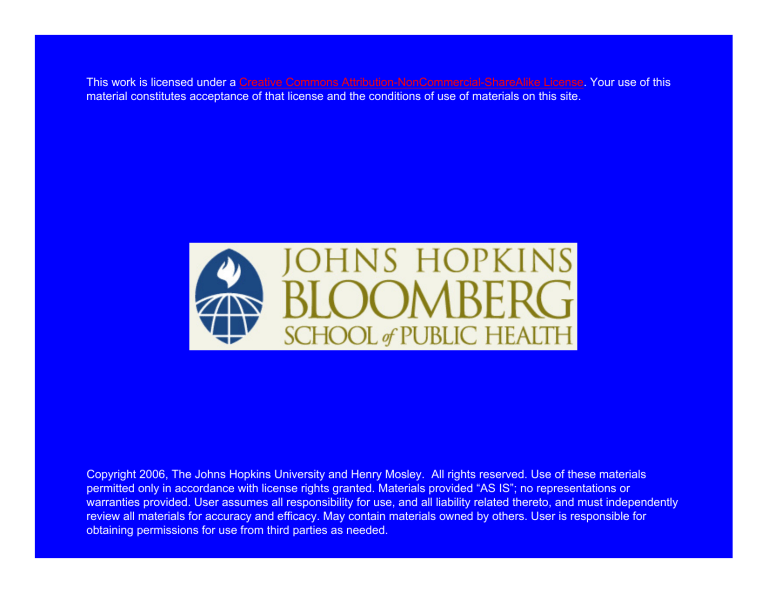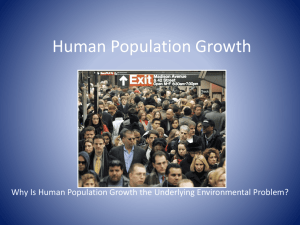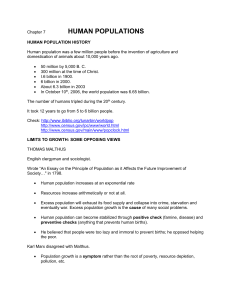Slides

This work is licensed under a Creative Commons Attribution-NonCommercial-ShareAlike License . Your use of this material constitutes acceptance of that license and the conditions of use of materials on this site.
Copyright 2006, The Johns Hopkins University and Henry Mosley. All rights reserved. Use of these materials permitted only in accordance with license rights granted. Materials provided “AS IS”; no representations or warranties provided. User assumes all responsibility for use, and all liability related thereto, and must independently review all materials for accuracy and efficacy. May contain materials owned by others. User is responsible for obtaining permissions for use from third parties as needed.
Population Size and Growth
Module 1a
Learning Objectives
Upon completion of this module, the student will be able to:
♦
List the historical and current sources of population data
♦
Comment on data quality and completeness
♦
Define and analyze demographic transition
3
A Definition of Population Study
♦
A study of the numbers and kinds of people in an area and their changes
♦
Seeking explanations for the patterns of variation in a population and causes of changes
♦
Projecting future changes and analyzing future consequences
Demography
Definition
♦
Demography is the statistical analysis of population data.
5
Sources of Population Data
♦
Historical Sources
– Methods of subsistence
– Eye-witness accounts
– Archeological remains
– Genealogies
–Cemetery data
–Church records
–Military records
–Numbers/sizes of towns
–Censuses
Sources of Population Data
♦
Current Sources
– Censuses
– Civil/vital registration
– Surveys
– Public records
– Private records
– Population registers
– Linked records estimates
Population Topics
♦
Population size and distribution
♦
Mortality and morbidity
♦
Fertility and contraception
♦
Mobility and migration
♦
Population composition – age, sex, race, ethnicity
♦
Population characteristics – education, economic status, marital and family status, living patterns
8
World Population Milestones
World population reached
1 billion in 1804
2 billion in 1927 (123 years later)
3 billion in 1960 (33 years later)
4 billion in 1974 (14 years later)
5 billion in 1987 (13 years later)
6 billion in 1999 (13 years later) source: UN, World Population Prospects: The 1998 revision
9
Population Milestones in Sub-
Saharan Africa
183 million in 1959
183*2 =366 million in 1978, 28 years later
183*3=549 million in 1992, 14 years later
183*4= 732 million in 2004 (estimated projection),12 years later
10
World Population Growth:
1750-2050
11
The Classic Stages of Demographic Transition
Stage 1 Stage 2
Stage 3 Stage 4
Natural increase
Births
Deaths
Time
Note: Natural increase is produced by the difference between births and deaths.
12
Demographic Transition:
What Is It?
♦
Shift from high rate of births and deaths to low rates of births and deaths
♦
Concept evolved from the history of population growth in Europe and the
United States and has been broadly applied to populations everywhere
13
The Classic Stages of the
Demographic Transition
♦
Stage I: high death rates balance high birth rates resulting in no, or slow population growth (or decline)
♦
Stage II : The death rates begin to drop with birth rates remaining high leading to increasing rates of population growth
14
The Classic Stages of the
Demographic Transition
(cont’d)
♦
Stage III: The birth rate declines resulting in a slowing of population growth
♦
Stage IV: both birth rates and death rates are low and population growth slows, stops or even declines
15
Demographic Transition:
Where are we now?
♦
Guided by the experience of developed world,most experts expect this demographic transition to occur through out the world. But there is no guarantee,this will happen.
♦
Individual countries are following different time tables and paths for achieving it
16
Demographic Transition
European vs. LDCs
♦
European countries
– BR and DR low over entire time period
– Gradual decline in mortality and fertility over 200 years
– Population growth rates peaked in 19 th century, at 1-2% per year
♦
Developing countries
– High pre-transition BR and DR,prior to World
War II
– Precipitous decline in mortality post World
War`II
– Population growth rates peaked in 2 nd half of 20 th century, at 2.5-3.5% per year
17
Demographic Transition:
Where are we now?
(cont’d)
♦
Western Europe, US, Canada, Australia, New
Zealand, Japan, China– essentially have completed the four stages of demographic transition.
♦
East Asia, Latin America, Middle East, South
Africa – mostly in Stage 3.
♦
South Asia (Pakistan), Sub-Saharan Africa – mostly in Stage 2.
18
Demographic Transition:
What After Stage 4?
♦
Balanced numbers of births and deaths with population size stabilizing ?
OR
♦
Continued declines of birth rates so that population numbers decline?
– Most of Western Europe has shown a continued birth rate decline below the 2-child family with beginning declines in population size.
19
Deviations from Classic
Stages of Demographic
Transition
Some current trends –
♦
Former Soviet Union, Eastern Europe – since 1989, a demographic “reversal” with a return of high mortality, continued low fertility and population decline
♦
Reversal in mortality gains with HIV epidemic in Sub-Saharan Africa
20
Projected Effect of AIDS on Life Expectancy in Sub-Saharan Africa by the Year 2010
With AIDS Without AIDS
Zimbabwe
33.1
69.9
South Africa
47.8
54.5
67.9
Uganda
35.2
Nigeria
59.7
64.9
69.2
Kenya
43.2
Congo
51.3
59.8
0 20 40
Life Expectancy
60
Source: U.S. Bureau of Census International Programs, 1997
80
21
Summary
This concludes this module.
The key concepts introduced in the module:
♦
Sources of population data
♦
Overview of population growth in SSA and world
♦
Demographic transition
22
Population Size and Growth
Module 1b
Learning Objectives
♦
Describe the dynamics of population growth over time.
♦
Compare an contrast the population growth rates in more developed and less developed countries with specific attention to sub-Saharan Africa
24
World Population Growth:
1750-2050
25
Population Change:
Before 1800
♦
Exceedingly slow population growth
♦
High birth rates offset by high mortality from wars, famines and epidemics
♦
World population size reached 1 billion around 1800
26
Population Change:
1800 to 1900
♦
Continuing mortality decline in European populations with early industrialization
♦
European population growth contributed to a surge of international migration
♦
Developing country populations growing very slowly
♦
World population reaches 1.7 billion by 1900
27
Population Change:
1900 to 1950
♦
Mortality in MDC declines further accompanied by declines in fertility
♦
Most of the Asia, Africa and Latin
America still facing high fertility and mortality, though mortality begins to decline in some countries.
♦
Population reaches 2.5 billion by the middle of the century
28
Population Change:
1700 to 1950
Population in Millions
Region 1700 1950 % increase
MDC
LDC
World
180
589
769
752
1776
2528
318%
202%
229%
29
World Population growth:
1950 - 2050
30
Population Change:
1950 to 2000
♦
MDC: Completion of transition to low mortality and low fertility
♦
LDC: Rapid reductions in death rates following World War II with birth rates remaining high for about two decades leading to dramatic population growth in most countries
31
Population Change:
1950 to 2000
(cont’d)
♦
Fertility declines begin the last quarter of the century in less developed countries – more rapid in Latin America and East Asia, slower in South Asia and Africa.
♦
LDCs population share increases from twothirds to four-fifths of total world population.
♦
World population reaches 6.2 billion by 2000.
32
Population Change:
1950 to 2000
Population in Millions
Region 1950 2000
MDC 752 1143
LDC 1766 5110
SSA 183 661
World 2518 6253
% increase
52%
189%
361%
148%
33
Population growth dynamics in Uganda and South Africa (1950-2000)
45
40
35
30
25
20
15
10
5
0
Uganda South Africa
0 0 0 0 0 0 0
195 196 197 198 199 200 201
Source: UN, Population revision estimates,1998, based on medium fertility projections
34
World Population Projections
By 2050,world population would reach between 7.3 billion and 10.7 billion depending upon fertility trends
35
Population Prospects
Some Certainties About Growth
♦
At least 1.3 billion people will be added to the world’s population over the next
25 years- there are 3 reasons for this inevitable growth:
– Fertility in LDC is twice as high as in MDC
– The young age structure of less developed countries constitutes momentum for population growth for several decades.
– Continuing improvements in mortality will contribute to additional growth.
36
Population Prospects:
Beyond 2000
♦
Nearly all future growth will take place in less developed countries – mostly India and sub-Saharan Africa.
♦
More dramatic redistribution of population among the more developed and less developed countries
37
Population Prospects
Major Uncertainties
♦
Future population size will depend not only on whether fertility will fall,but how quickly it declines and to what level it falls.
♦
The demographic impact of the global AIDS epidemic in the next 25 years is still difficult to project.
38
Summary Slide
♦
This concludes this session
♦
The topics introduced in this session
– Dynamics of population growth from 1750-
2050
– Population growth rates in more developed and less developed countries
– World population projections under three fertility scenarios
39
Population Size and Growth
Module 1c
Learning Objectives
♦
Describe components of population change (demographic balancing equation)
♦
Define and calculate the crude rate of natural increase and population growth rate
♦
Show the relationship between growth rate and doubling time of a population
41
Measuring Population Change :
Three Basic Demographic Processes
♦
Births
♦
Deaths
♦
Migration
Immigration
Births
Population Emigration
Deaths
42
Measuring Population Change
Demographic Balancing Equation
♦
Population change = (Births - Deaths) +
(Immigrants - Emigrants)
♦
Or using the common notation, it can be expressed:
P t
- P
0
= (B - D) + (I- E) where:
P
0 is the initial population and P time t t is the population after
43
Measuring Population Change
Demographic Balancing Equation
P t
- P
0
= (B - D) + (I- E)
USA Example
Population Change, 1990 – 1991 (numbers in thousands)
250,878 - 248,168 = 4,179 - 2,162 + 853 - 160
44
Demographic Balancing Equation
(cont’d)
♦
Can be split into 2 basic components:
Natural increase = Births (B) – Deaths (D)
Net Migration = Immigration (I) – Emigration (E)
♦
In almost all countries, natural increase is the most important component of overall population change over time
45
Measuring Population Change
Calculation of Rates
♦
Each component of population change
(births, deaths, migration) can be expressed as an absolute number, or more commonly, as annual rates.
♦
A Rate always has 3 components: a numerator, a denominator and a time period.
46
Measuring Population Change
Calculation of Rates
(cont’d)
♦
The denominator for the calculation of an annual rate is the estimated mid-year population.
♦
Demographic rates are ordinarily calculated per 1000 persons per year.
47
Measuring Population Change
Calculation of Rates
(cont’d)
♦
E.g. the Crude Birth Rate (CBR) can be calculated as total number of live births per year per thousand mid-year population
Number of
Total Mid -
Births in 1 Year
Year Population
×
1000
♦
The other rates are calculated similarly
48
Measuring Population Change
Calculation of Rates
(cont’d)
Crude Birth Rate (CBR) =
Mid-year population
Crude Death Rate (CDR) =
Mid-year population
Crude Rate of Natural Increase (CRNI) =
CBR – CDR
Note: the CRNI is most often expressed as a percent (%) and is
Often used as the measure of the annual rate of population growth.
Measuring Population Change
Population Growth Equations
♦
The average rate of population growth over some extended time period can be calculated if the population size at the two points in time are known.
♦
This is best done by using the exponential growth formula.
50
Measuring Population Change
Population Growth Equations
♦
Exponential growth : this is calculated like the growth of an investment with compound interest.
♦
With the exponential growth equation, compounding takes place continuously rather than just annually, i.e. a constant rate of change is applied at every infinitesimal moment of time.
51
Measuring Population Change
Exponential Growth Equation
P n
= P o e rn where:
P n
= population at time n
P o
= population at time o n = number of years r = annual rate of growth e = base of the natural logarithm
Measuring Population Change
Population Doubling Time
♦
Population hypothetical doubling time = the number of years until the population will double if the annual rate of growth remains constant
♦
Rule of 70: doubling time = 70 / r %
♦
E.g. at the growth rate of 2.8% per year, the population of Uganda would double in 70/2.8 = 24 years if that growth rate remained unchanged.
53
Doubling time
The “rule of 70”
Rate of Growth = r % Years to Double
0.1
0.5
1.0
2.0
3.0
4.0
700
140
70
35
23.3
17.5
Source: US Census Bureau
55
Summary of Recent Trends
♦
World population growth rate reached a peak of about 2.1% per year in the late 1960s and has been declining ever since.
♦
The numbers added to the world’s population annually increased from around 75 million in the 1960s to 90 million in the 1990s before beginning to slowly decline.
♦
The highest rates of population growth and largest numbers being added are in the developing countries.
56
Summary Slide
♦
This concludes this session and the module on population size and growth
♦
Topics introduced in this session
– Demographic balancing equation
– Population growth equation
– Population doubling time
57








